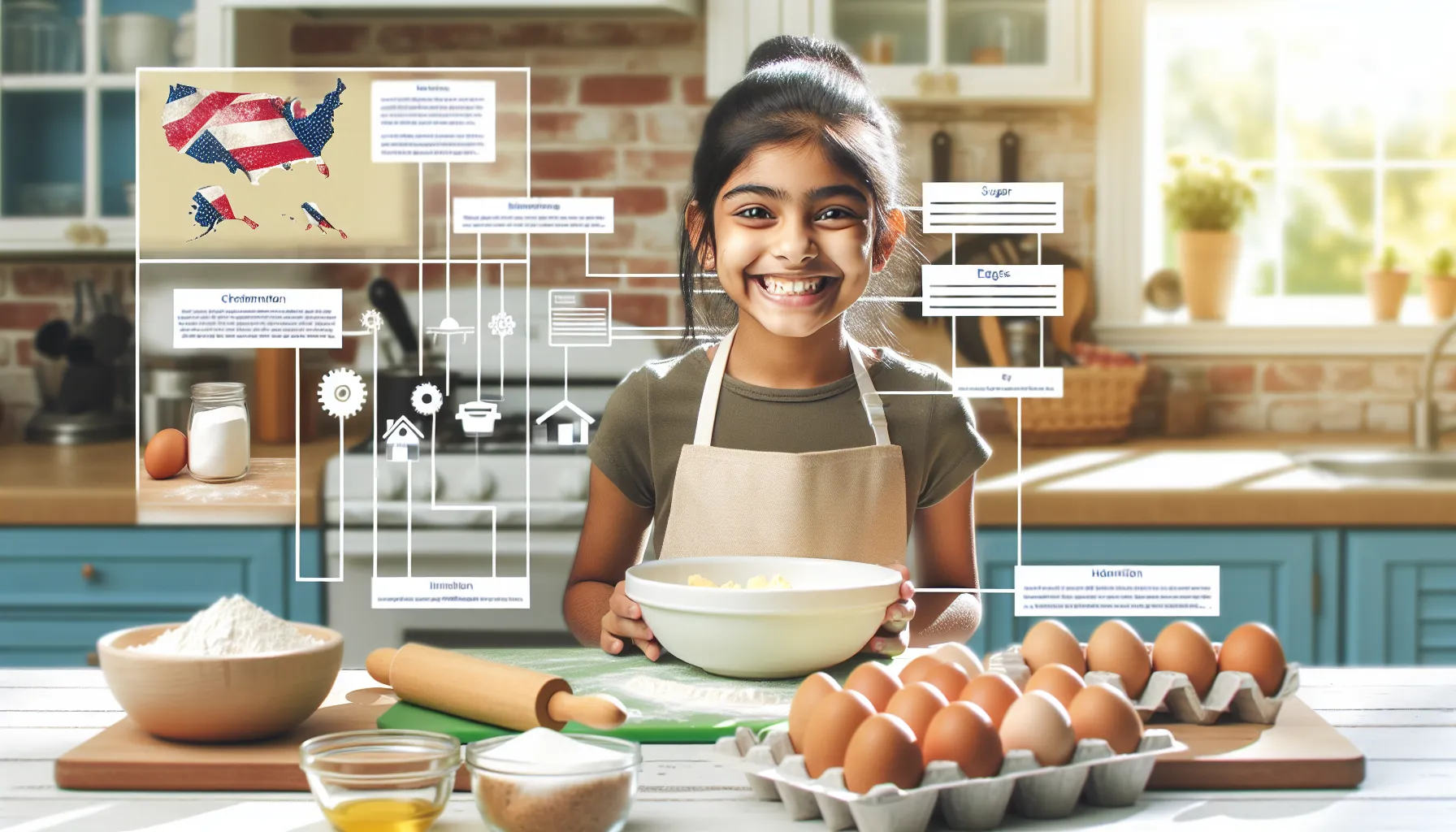
Key Takeaways
- Step-by-step recipes enhance homeschool learning by teaching practical skills such as reading instructions, measuring, sequencing, and basic science concepts.
- Baking encourages hands-on, interactive learning through real-world applications of math, science, and problem-solving while fostering creativity and critical thinking.
- Cooking together strengthens family bonds by promoting teamwork, communication, and shared accomplishments that create lasting memories.
- Organized and accessible kitchens simplify the process, ensuring a smoother experience for both kids and parents while teaching responsibility and organization.
- Simple, age-appropriate tasks keep children engaged, building their confidence and life skills with minimal frustration and plenty of fun opportunities for creativity.
- Recipes connect education with enjoyment, making lessons more meaningful and memorable through the satisfaction of creating and sharing homemade meals.
Homeschooling offers endless opportunities for hands-on learning, and what better way to combine education and fun than through baking? Cooking in the kitchen isn’t just about creating delicious treats—it’s a chance to teach essential skills like reading instructions, measuring ingredients, and understanding basic science. For many of us, finding activities that engage and educate can feel challenging, but baking provides the perfect blend of creativity and practicality.
Have you ever noticed how much kids light up when they’re involved in making something? Step-by-step recipes are a fantastic way to guide young learners through a structured yet enjoyable process. They can practice following directions while gaining confidence in their abilities. Plus, the reward of a homemade treat at the end makes the effort even sweeter. Together, we can turn everyday moments into meaningful learning experiences that spark curiosity and build lasting memories.
Benefits Of Step-By-Step Recipes For Homeschool
Step-by-step recipes simplify the learning process. By providing clear instructions, they reduce confusion and help children focus on each task. This structure is particularly helpful for young learners who are still developing their ability to follow sequences and interpret directions.
These recipes teach practical skills. Working through measured steps improves reading comprehension, logical thinking, and sequencing abilities. For instance, reading a recipe teaches how to interpret written instructions, while organizing tools highlights problem-solving skills.
Baking encourages hands-on learning. Active participation reinforces educational concepts like math through measurements and science through chemical reactions. Mixing ingredients demonstrates how substances can change form, offering a practical understanding of theoretical ideas.
Structured recipes build confidence. Completing a recipe successfully, even with guidance, gives children a sense of accomplishment. This achievement fosters self-assurance, especially as they master more complex tasks over time.
Cooking together strengthens family bonds. Parents and children engaging in shared activities create opportunities for meaningful interactions. These moments encourage communication and teamwork, which adds value beyond academics.
Using recipes sparks creativity. While instructions provide a foundation, they also allow room for customization. Children can experiment with flavors, decorations, or presentation, blending imagination with practical learning.
Step-by-step preparations make learning memorable. By connecting practical tasks with enjoyable results, baking transforms routine homeschool lessons into valuable experiences that children remember and cherish.
Essential Tips For Successful Cooking At Home

Cooking with kids at home blends learning and bonding while creating delicious food. Making it a seamless experience benefits from some thoughtful preparation and involvement.
Organizing Your Kitchen
A well-organized kitchen provides a smoother cooking process. Group ingredients and tools in advance to minimize searching while cooking. Keep commonly used items like mixing bowls, measuring cups, and spoons accessible. Clear counter space to avoid clutter and distractions.
Labeling storage containers helps children identify items independently. Use trays or bins to separate dry, wet, and measuring ingredients. This setup not only streamlines the recipe steps but also teaches kids organization.
Choosing Simple Ingredients
Simple ingredients help children stay focused on learning techniques rather than managing overly complex recipes. Opt for staples like flour, sugar, eggs, and butter. These basics provide opportunities to explore a range of recipes, from cookies to cakes.
Fresh, easy-to-handle ingredients also add a sensory learning aspect. Show kids how to measure liquids, scoop powders, or crack eggs. Questions like, “What happens when we mix dry and wet ingredients?” spark curiosity and participation.
Involving Kids In The Process
Engaging kids actively fosters excitement and learning. Let them handle tasks matched to their skill level—mixing batter, measuring flour, or reading the recipe aloud. These responsibilities build confidence and develop hands-on skills.
Ask open-ended questions like, “How would you decorate this treat?” to inspire creativity. Encourage teamwork by dividing tasks between siblings or family members. Celebrate their effort, no matter the outcome, to make the experience rewarding.
Easy Step-By-Step Recipes For Homeschool

Making recipes part of homeschooling creates learning moments that are both enjoyable and practical. With easy instructions, kids of various ages can actively participate and develop valuable life skills. Let’s explore some meal ideas that can simplify your homeschool routine.
Breakfast Ideas
Starting the day with a homemade meal sets a positive tone for learning. Recipes like simple pancakes, scrambled eggs, or yogurt parfaits help children practice measurement and sequencing. Have you considered how cooking breakfast can reinforce math concepts like fractions and addition?
Engaging children in breakfast prep builds confidence. Tasks like mixing ingredients or layering parfaits help younger learners with motor skills. Older kids can manage recipes independently, strengthening their problem-solving abilities while keeping mornings productive.
Lunch Recipes
Lunch offers another opportunity for structured learning. Dishes such as pasta salads, quesadillas, or homemade wraps teach kids about following multi-step directions. What better way to encourage following instructions than creating something delicious together?
Assign age-appropriate tasks to make lunch more collaborative. Younger children can wash vegetables or spread fillings, while older ones manage cooking tasks like grilling sandwiches. This shared effort keeps learning interactive and builds teamwork.
Fun Snacks And Desserts
Baking cookies, cupcakes, or making trail mix adds excitement to the homeschool schedule. Interactive recipes allow children to count, measure, and organize ingredients. Plus, they’re a creative outlet. How can adding a few sprinkles or shaping cookies into fun designs inspire your child’s creativity?
Hands-on activities like kneading dough or decorating baked goods are not only fun but help develop sensory awareness. Including fun snacks in lessons teaches kids patience and precision, skills they’ll use in every part of their lives. Celebrate each creation to keep them motivated and eager for the next session.
Teaching Life Skills Through Cooking
Cooking offers more than just the opportunity to make meals—it helps children develop essential life skills. By involving kids in the kitchen, we can teach them practical abilities while creating a hands-on, educational experience that prepares them for the future.
Understanding Measurements
Learning to measure ingredients introduces children to essential math skills. Tasks like reading numbers on a measuring cup or scaling measurements for a recipe emphasize concepts such as fractions and ratios. This practice strengthens their ability to perform basic calculations in real-world scenarios.
Wouldn’t it be rewarding to see them confidently measure flour or sugar while understanding the math behind it? Encouraging attention to detail when measuring ingredients supports precision and critical thinking.
Encouraging Collaboration And Creativity
Cooking together builds a sense of teamwork. Assigning responsibilities such as mixing or decorating teaches cooperation and communication. Asking questions like “What do you think this recipe needs?” inspires creativity, helping children share their ideas and take part in decision-making.
Recipes also provide a structure that allows flexibility. For instance, kids can choose toppings for a pizza or decide the icing colors for cupcakes. Allowing them to make these choices nurtures their imagination and problem-solving skills. What tasks can your children take on to feel involved in the cooking process?
Conclusion
Baking and cooking are powerful tools for making homeschooling both educational and enjoyable. By incorporating step-by-step recipes, we can teach essential skills, spark creativity, and strengthen family connections. These hands-on experiences go beyond academics, helping our children build confidence and develop practical abilities they’ll use for a lifetime.
When we involve kids in the kitchen, we’re not just preparing meals—we’re creating meaningful moments and valuable learning opportunities. With a little preparation and encouragement, we can turn everyday cooking into a fun and interactive way to grow together as a family.
Frequently Asked Questions
Why is baking beneficial for homeschooling?
Baking is beneficial for homeschooling because it combines fun with education. It teaches kids essential skills like reading instructions, measuring, and basic science concepts. Additionally, baking improves math, logical thinking, and problem-solving, while boosting confidence and creating meaningful learning experiences.
How does cooking help develop life skills in children?
Cooking helps children learn life skills such as organization, teamwork, communication, and critical thinking. Measuring ingredients reinforces math concepts, while following recipes sharpens attention to detail. It also nurtures creativity by allowing kids to make choices during the process.
What are the best recipes to start with for kids?
Simple recipes like pancakes, scrambled eggs, cookies, and cupcakes are great for kids. These recipes involve basic techniques such as mixing, measuring, and sequencing, making them ideal for reinforcing skills while keeping the experience enjoyable and educational.
How can I make baking more engaging for my child?
To make baking engaging, involve kids in age-appropriate tasks, ask open-ended questions to spark creativity, and allow room for experimentation. Celebrate their efforts, regardless of the outcome, to build their confidence and make the experience rewarding.
What are the benefits of using step-by-step recipes in homeschooling?
Step-by-step recipes make learning easier by providing clear instructions that reduce confusion and improve focus. They help kids practice sequencing, reading comprehension, and logical thinking while encouraging hands-on engagement.
Why is hands-on learning important in homeschooling?
Hands-on learning, like baking, reinforces concepts such as math and science through practical application. It boosts retention, builds confidence by accomplishing tasks, and creates lasting memories, making education more interactive and enjoyable.
How can I prepare my kitchen for homeschooling activities like baking?
Organize your kitchen by grouping ingredients and tools in advance. Keep commonly used items accessible and label storage containers for easy identification. This helps kids stay focused and learn organization and independence.
How can baking strengthen family bonds?
Baking fosters teamwork, communication, and collaboration as family members work together on recipes. It provides quality time for parents and children to connect, share experiences, and create lasting memories during the homeschooling journey.
What skills can my child learn from measuring ingredients?
Measuring ingredients helps children understand math concepts like fractions, ratios, and volume. It also improves attention to detail, precision, and critical thinking, which are valuable skills for everyday life.
How can I encourage creativity in the cooking process?
Encourage creativity by letting kids choose ingredients, modify recipes, and decorate their creations. This nurtures their imagination, problem-solving skills, and confidence while making the learning process fun and interactive.

